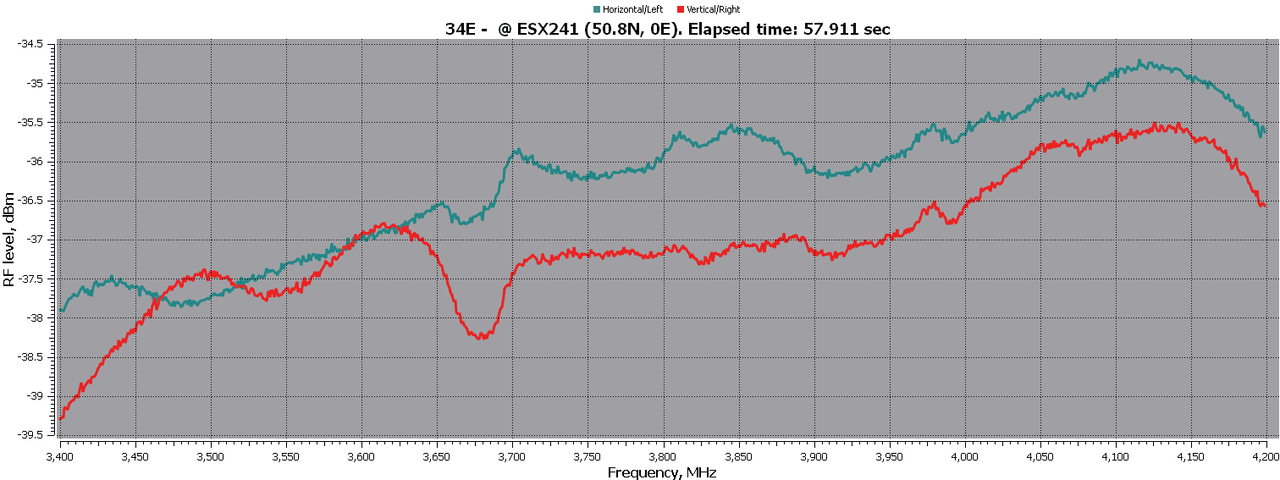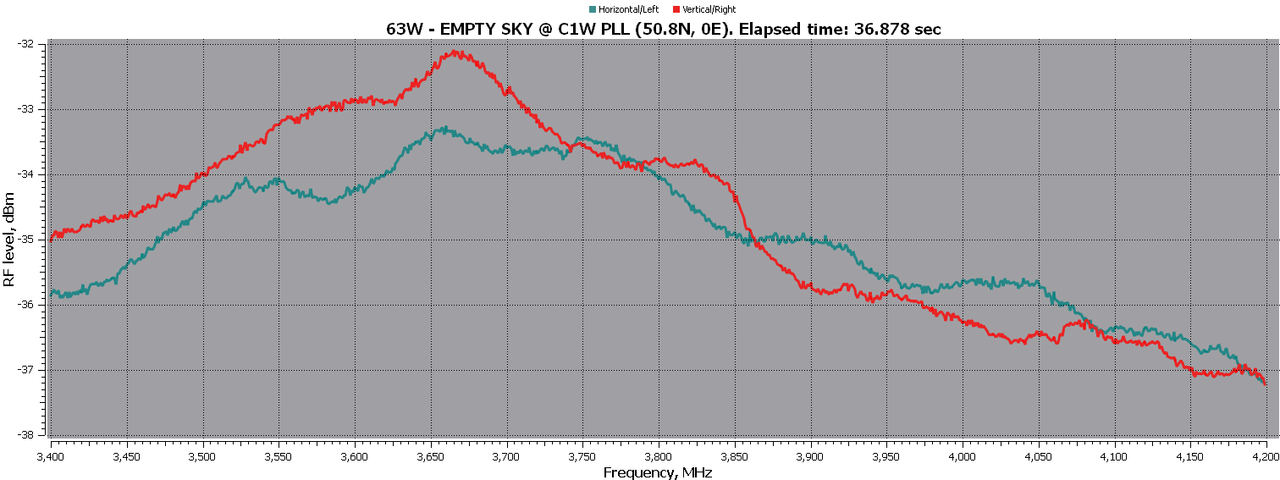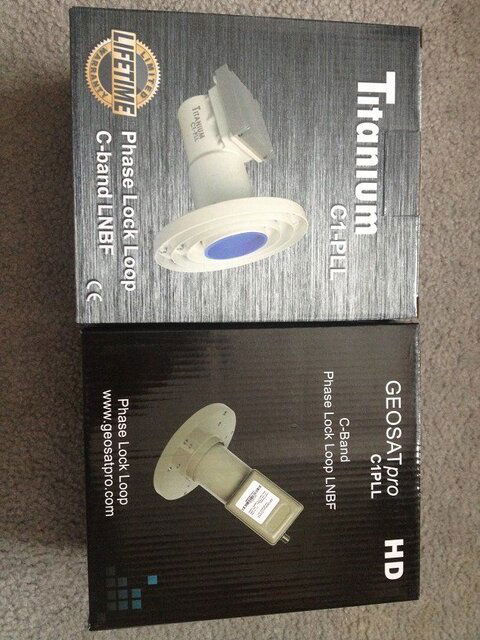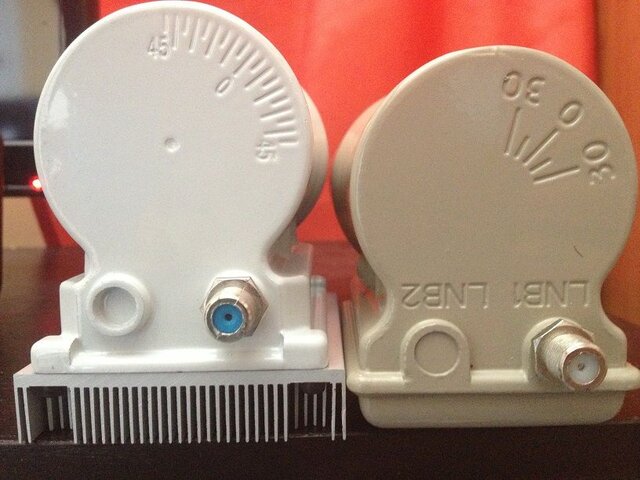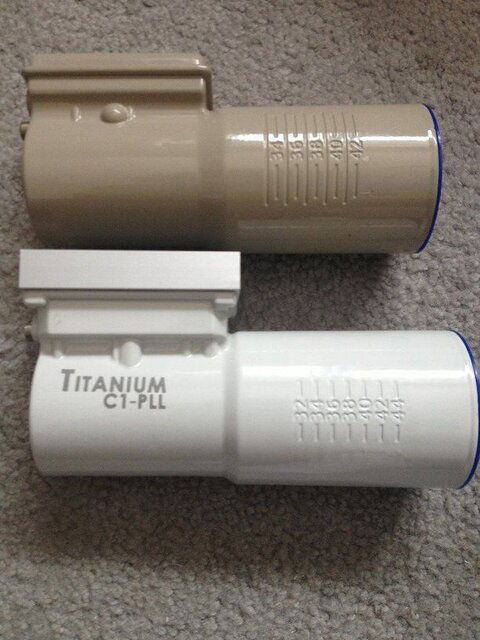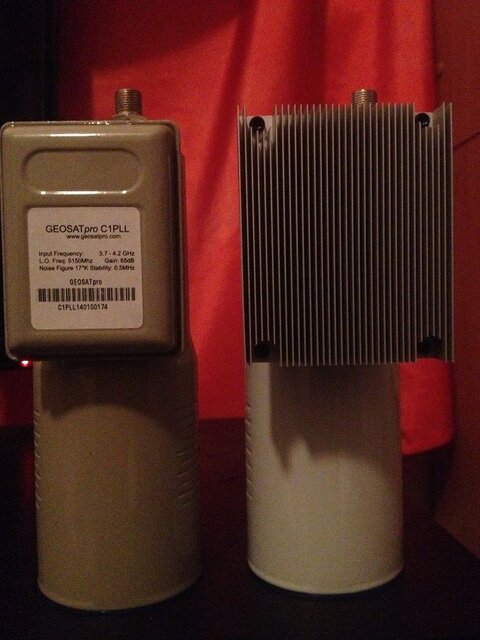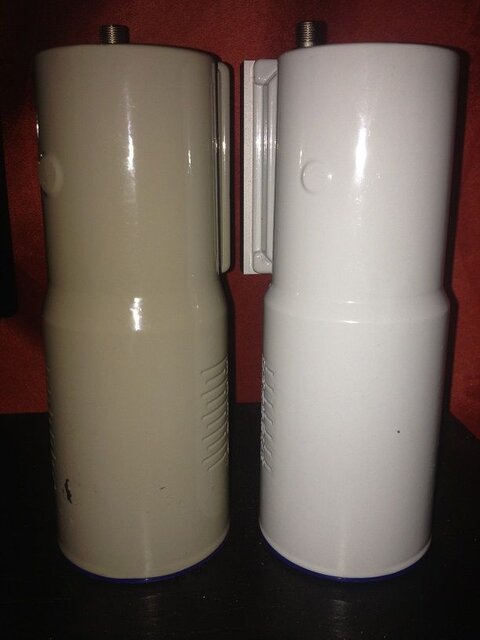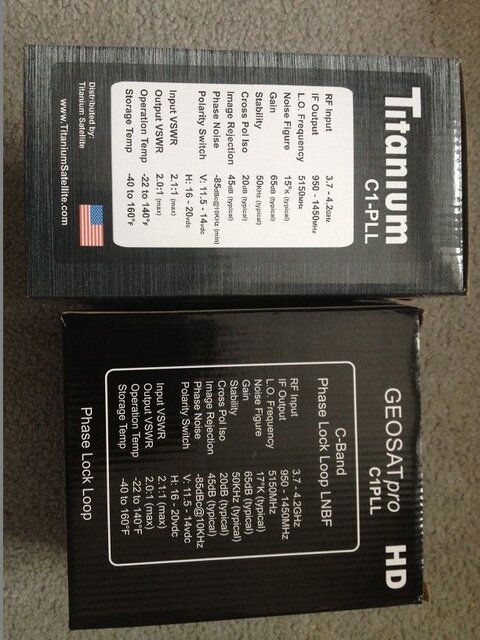I've been testing two C1Ws for the last week, nothing scientific but comparing them to my existing ESX241. My set up is a Precision Antennas 1.8m diameter spun aluminium Prime Focus and Prof Tuners 8000 PCIe card. The figures are obtained using a mix of DVB Dream and Crazyscan software, the Dream SQ reading is included for simple comparison. Some variations are due to differing times of the afternoon and varying amounts of cloud cover but I've tried to minimise these. The Scalar is the original Precision model.
As you can see there's no clear winner but the new C1W does just about come out on top with regard to SNR on many signals. In addition to the listed results there are a couple of very weak transponders that I've gained albeit TOD dependent on 38°E using the C1W. Further tests are to be done as soon as I have time comparing results on a 1.2m offset Gibertini, I've heard they perform particularly well on small offset dishes with a suitable scalar. I also need to find some low frequency, low SR 8PSK signals to compare it against the 241.
In addition to testing the LNBs I also compared #1s performance using different dielectric plates, I have three to choose from. The first is the regular one shipped with nearly all C band LNBs, the second is a homebrew plate affectionately known as the chopping board plate, it's 10mm thick nylon and large enough that it slides into the LNB throat but also locates into the scalar. The third design is based on a Doktorofsat design made from the case of a DVD with tuned sections of adhesive copper strip, this is slid into the LNB throat. One surprise was on initial installation, the plate needs to be orientated 90° from the way it fits into the ESX241. My everyday plate is the DoktorofSat, apart from a couple of narrow frequency bands it outperforms either of the other two by upto 1.5dB SNR. the chopping board plate is usually to hand if I'm trying to obtain a weak transponder as it can occasionally produce results the DoS plate can't.
In addition to simply swapping plates I also rotated the LNB 90°, rotated the plate to match and switched polarity to compare the performance, the same was done using linear transponders. In each test the horizontal/LHC element of the LNB was superior by about 0.4dB SNR
So in conclusion I'm happy with my purchase, gains over the ESX241 are marginal for me but they are there and with the C1W being so competitively priced I'm more than happy to recommend them as the LNB to chose. Having spoken to other users that were using the BSX421 prior to the C1W they've seen more dramatic improvements in performance and report numerous new locking transponders, both linear and circular. Once I've finished comparing results I intend to mount the C1W onto my 1.2M offset alongside the Ku LNB to obtain some birds to my extreme East beyond the reach of the 1.8m.
I'd also like to add my thanks to Brian from Titanium, he really knows what good customer service means and it's been a pleasure dealing with him, another reason to recommend his products.
SATELLITE...................ESX241.......................C1W-PLL #1..........................C1W-PLL #2
[TD="class: xl24"][/TD]
[TD="class: xl24"][/TD]
[TD="class: xl25"]SQ[/TD]
[TD="class: xl25"]SNR[/TD]
[TD="class: xl25"]RF[/TD]
[TD="class: xl25"][/TD]
[TD="class: xl25"]SQ[/TD]
[TD="class: xl25"]SNR[/TD]
[TD="class: xl25"]RF[/TD]
[TD="class: xl25"][/TD]
[TD="class: xl25"]SQ[/TD]
[TD="class: xl25"]SNR[/TD]
[TD="class: xl25, width: 36"]RF[/TD]
[TD="class: xl25"]20E[/TD]
[TD="class: xl25"]3798L[/TD]
[TD="class: xl25"]85/46[/TD]
[TD="class: xl25"]6.4[/TD]
[TD="class: xl25"]-32[/TD]
[TD="class: xl25"][/TD]
[TD="class: xl25"]87/34[/TD]
[TD="class: xl25"]5.9[/TD]
[TD="class: xl25"]-30[/TD]
[TD="class: xl25"][/TD]
[TD="class: xl25"]87/14[/TD]
[TD="class: xl25"]4.8[/TD]
[TD="class: xl25"]-31[/TD]
[TD="class: xl25"][/TD]
[TD="class: xl25"][/TD]
[TD="class: xl25"][/TD]
[TD="class: xl25"][/TD]
[TD="class: xl25"][/TD]
[TD="class: xl25"][/TD]
[TD="class: xl25"][/TD]
[TD="class: xl25"][/TD]
[TD="class: xl25"][/TD]
[TD="class: xl25"][/TD]
[TD="class: xl25"][/TD]
[TD="class: xl25"][/TD]
[TD="class: xl25"][/TD]
[TD="class: xl25"]1W[/TD]
[TD="class: xl25"]4084L[/TD]
[TD="class: xl25"]85/22[/TD]
[TD="class: xl25"]5.2[/TD]
[TD="class: xl25"]-32[/TD]
[TD="class: xl25"][/TD]
[TD="class: xl25"]No sig[/TD]
[TD="class: xl25"][/TD]
[TD="class: xl25"][/TD]
[TD="class: xl25"][/TD]
[TD="class: xl25"]83/20[/TD]
[TD="class: xl25"]5.3[/TD]
[TD="class: xl25"]-34[/TD]
[TD="class: xl25"]1W[/TD]
[TD="class: xl25"]4175R[/TD]
[TD="class: xl25"]85/50[/TD]
[TD="class: xl25"]6.8[/TD]
[TD="class: xl25"]-28[/TD]
[TD="class: xl25"][/TD]
[TD="class: xl25"][/TD]
[TD="class: xl25"]6.5[/TD]
[TD="class: xl25"]-29[/TD]
[TD="class: xl25"][/TD]
[TD="class: xl25"]83/58[/TD]
[TD="class: xl25"]7.1[/TD]
[TD="class: xl25"]-30[/TD]
[TD="class: xl25"][/TD]
[TD="class: xl25"][/TD]
[TD="class: xl25"][/TD]
[TD="class: xl25"][/TD]
[TD="class: xl25"][/TD]
[TD="class: xl25"][/TD]
[TD="class: xl25"][/TD]
[TD="class: xl25"][/TD]
[TD="class: xl25"][/TD]
[TD="class: xl25"][/TD]
[TD="class: xl25"][/TD]
[TD="class: xl25"][/TD]
[TD="class: xl25"][/TD]
[TD="class: xl25"]5W[/TD]
[TD="class: xl25"]3633R[/TD]
[TD="class: xl25"]87/49[/TD]
[TD="class: xl25"]8.5[/TD]
[TD="class: xl25"]-31[/TD]
[TD="class: xl25"][/TD]
[TD="class: xl25"]94/34[/TD]
[TD="class: xl25"]7.8[/TD]
[TD="class: xl25"]-25[/TD]
[TD="class: xl25"][/TD]
[TD="class: xl25"]95/39[/TD]
[TD="class: xl25"]8.1[/TD]
[TD="class: xl25"][/TD]
[TD="class: xl25"]5W[/TD]
[TD="class: xl25"]3723L[/TD]
[TD="class: xl25"]89/55[/TD]
[TD="class: xl25"]8.4[/TD]
[TD="class: xl25"]-29[/TD]
[TD="class: xl25"][/TD]
[TD="class: xl25"]93/31[/TD]
[TD="class: xl25"]8.7[/TD]
[TD="class: xl25"]-25[/TD]
[TD="class: xl25"][/TD]
[TD="class: xl25"]No sig[/TD]
[TD="class: xl25"][/TD]
[TD="class: xl25"][/TD]
[TD="class: xl25"][/TD]
[TD="class: xl25"][/TD]
[TD="class: xl25"][/TD]
[TD="class: xl25"][/TD]
[TD="class: xl25"][/TD]
[TD="class: xl25"][/TD]
[TD="class: xl25"][/TD]
[TD="class: xl25"][/TD]
[TD="class: xl25"][/TD]
[TD="class: xl25"][/TD]
[TD="class: xl25"][/TD]
[TD="class: xl25"][/TD]
[TD="class: xl25"][/TD]
[TD="class: xl25"]22W[/TD]
[TD="class: xl25"]3695R[/TD]
[TD="class: xl25"]86/100[/TD]
[TD="class: xl25"]6.9[/TD]
[TD="class: xl25"]-32[/TD]
[TD="class: xl25"][/TD]
[TD="class: xl25"]92/100[/TD]
[TD="class: xl25"]9.5[/TD]
[TD="class: xl25"]-25[/TD]
[TD="class: xl25"][/TD]
[TD="class: xl25"]93/100[/TD]
[TD="class: xl25"]9.6[/TD]
[TD="class: xl25"]-28[/TD]
[TD="class: xl25"]22W[/TD]
[TD="class: xl25"]3943L[/TD]
[TD="class: xl25"]88/81[/TD]
[TD="class: xl25"]8.2[/TD]
[TD="class: xl25"]-30[/TD]
[TD="class: xl25"][/TD]
[TD="class: xl25"]87/86[/TD]
[TD="class: xl25"]8.6[/TD]
[TD="class: xl25"]-30[/TD]
[TD="class: xl25"][/TD]
[TD="class: xl25"]87/85[/TD]
[TD="class: xl25"]8.5[/TD]
[TD="class: xl25"]-31[/TD]
[TD="class: xl25"][/TD]
[TD="class: xl25"][/TD]
[TD="class: xl25"][/TD]
[TD="class: xl25"][/TD]
[TD="class: xl25"][/TD]
[TD="class: xl25"][/TD]
[TD="class: xl25"][/TD]
[TD="class: xl25"][/TD]
[TD="class: xl25"][/TD]
[TD="class: xl25"][/TD]
[TD="class: xl25"][/TD]
[TD="class: xl25"][/TD]
[TD="class: xl25"][/TD]
[TD="class: xl25"]37.5W[/TD]
[TD="class: xl25"] 3749H[/TD]
[TD="class: xl25"]90/77[/TD]
[TD="class: xl25"]9.8[/TD]
[TD="class: xl25"]-28[/TD]
[TD="class: xl25"][/TD]
[TD="class: xl25"]93/96[/TD]
[TD="class: xl25"]10.8[/TD]
[TD="class: xl25"]-26[/TD]
[TD="class: xl25"][/TD]
[TD="class: xl25"]94/85[/TD]
[TD="class: xl25"]10.3[/TD]
[TD="class: xl25"]-25[/TD]
[TD="class: xl25"][/TD]
[TD="class: xl25"][/TD]
[TD="class: xl25"][/TD]
[TD="class: xl25"][/TD]
[TD="class: xl25"][/TD]
[TD="class: xl25"][/TD]
[TD="class: xl25"][/TD]
[TD="class: xl25"][/TD]
[TD="class: xl25"][/TD]
[TD="class: xl25"][/TD]
[TD="class: xl25"][/TD]
[TD="class: xl25"][/TD]
[TD="class: xl25"][/TD]
[TD="class: xl25"]40.5W[/TD]
[TD="class: xl25"] 3627L[/TD]
[TD="class: xl25"]86/55[/TD]
[TD="class: xl25"]10.2[/TD]
[TD="class: xl25"]-31[/TD]
[TD="class: xl25"][/TD]
[TD="class: xl25"]91/56[/TD]
[TD="class: xl25"]8[/TD]
[TD="class: xl25"]-28[/TD]
[TD="class: xl25"][/TD]
[TD="class: xl25"]92/58[/TD]
[TD="class: xl25"]10.2[/TD]
[TD="class: xl25"]-27[/TD]
[TD="class: xl25"]40.5W[/TD]
[TD="class: xl25"] 3673R[/TD]
[TD="class: xl25"]88/39[/TD]
[TD="class: xl25"]9.2[/TD]
[TD="class: xl25"]-30[/TD]
[TD="class: xl25"][/TD]
[TD="class: xl25"]92/100[/TD]
[TD="class: xl25"]8.3[/TD]
[TD="class: xl25"]-23[/TD]
[TD="class: xl25"][/TD]
[TD="class: xl25"]96/40[/TD]
[TD="class: xl25"]9.2[/TD]
[TD="class: xl25"]-22[/TD]
[TD="class: xl25"][/TD]
[TD="class: xl25"][/TD]
[TD="class: xl25"][/TD]
[TD="class: xl25"][/TD]
[TD="class: xl25"][/TD]
[TD="class: xl25"][/TD]
[TD="class: xl25"][/TD]
[TD="class: xl25"][/TD]
[TD="class: xl25"][/TD]
[TD="class: xl25"][/TD]
[TD="class: xl25"][/TD]
[TD="class: xl25"][/TD]
[TD="class: xl25"][/TD]
[TD="class: xl25"]43.1W[/TD]
[TD="class: xl25"] 3877V[/TD]
[TD="class: xl25"]84/87[/TD]
[TD="class: xl25"]7.4[/TD]
[TD="class: xl25"]-33[/TD]
[TD="class: xl25"][/TD]
[TD="class: xl25"]87/74[/TD]
[TD="class: xl25"]6.7[/TD]
[TD="class: xl25"]-30[/TD]
[TD="class: xl25"][/TD]
[TD="class: xl25"][/TD]
[TD="class: xl25"]4.2[/TD]
[TD="class: xl25"]-32[/TD]
[TD="class: xl25"][/TD]
[TD="class: xl25"][/TD]
[TD="class: xl25"][/TD]
[TD="class: xl25"][/TD]
[TD="class: xl25"][/TD]
[TD="class: xl25"][/TD]
[TD="class: xl25"][/TD]
[TD="class: xl25"][/TD]
[TD="class: xl25"][/TD]
[TD="class: xl25"][/TD]
[TD="class: xl25"][/TD]
[TD="class: xl25"][/TD]
[TD="class: xl25"][/TD]
[TD="class: xl25"]53W[/TD]
[TD="class: xl25"]3715V[/TD]
[TD="class: xl25"]84/43[/TD]
[TD="class: xl25"]5.5[/TD]
[TD="class: xl25"]-32[/TD]
[TD="class: xl25"][/TD]
[TD="class: xl25"]90/45[/TD]
[TD="class: xl25"]5.6[/TD]
[TD="class: xl25"]-28[/TD]
[TD="class: xl25"][/TD]
[TD="class: xl25"]90/55[/TD]
[TD="class: xl25"]6.2[/TD]
[TD="class: xl25"]-29[/TD]
[TD="class: xl25"][/TD]
[TD="class: xl25"][/TD]
[TD="class: xl25"][/TD]
[TD="class: xl25"][/TD]
[TD="class: xl25"][/TD]
[TD="class: xl25"][/TD]
[TD="class: xl25"][/TD]
[TD="class: xl25"][/TD]
[TD="class: xl25"][/TD]
[TD="class: xl25"][/TD]
[TD="class: xl25"][/TD]
[TD="class: xl25"][/TD]
[TD="class: xl25"][/TD]
[TD="class: xl25"]55W[/TD]
[TD="class: xl25"]3711V[/TD]
[TD="class: xl25"]86/26[/TD]
[TD="class: xl25"]8.5[/TD]
[TD="class: xl25"]-31[/TD]
[TD="class: xl25"][/TD]
[TD="class: xl25"]93/24[/TD]
[TD="class: xl25"]8.6[/TD]
[TD="class: xl25"]-25[/TD]
[TD="class: xl25"][/TD]
[TD="class: xl25"]93/43[/TD]
[TD="class: xl25"]9.4[/TD]
[TD="class: xl25"]-25[/TD]
[TD="class: xl25"]55W[/TD]
[TD="class: xl25"]4147h[/TD]
[TD="class: xl25"]91/42[/TD]
[TD="class: xl25"]6.2[/TD]
[TD="class: xl25"]-27[/TD]
[TD="class: xl25"][/TD]
[TD="class: xl25"]88/44[/TD]
[TD="class: xl25"]6.5[/TD]
[TD="class: xl25"]-29[/TD]
[TD="class: xl25"][/TD]
[TD="class: xl25"]87/43[/TD]
[TD="class: xl25"]6.4[/TD]
[TD="class: xl25"]-30[/TD]
[TD="class: xl25"][/TD]
[TD="class: xl25"][/TD]
[TD="class: xl25"][/TD]
[TD="class: xl25"][/TD]
[TD="class: xl25"][/TD]
[TD="class: xl25"][/TD]
[TD="class: xl25"][/TD]
[TD="class: xl25"][/TD]
[TD="class: xl25"][/TD]
[TD="class: xl25"][/TD]
[TD="class: xl25"][/TD]
[TD="class: xl25"][/TD]
[TD="class: xl25"][/TD]
[TD="class: xl25"]58W[/TD]
[TD="class: xl25"]4174v[/TD]
[TD="class: xl25"]85/40[/TD]
[TD="class: xl25"]6.1[/TD]
[TD="class: xl25"]-32[/TD]
[TD="class: xl25"][/TD]
[TD="class: xl25"]85/26[/TD]
[TD="class: xl25"]5.5[/TD]
[TD="class: xl25"]-31[/TD]
[TD="class: xl25"][/TD]
[TD="class: xl25"]82/37[/TD]
[TD="class: xl25"]7.1[/TD]
[TD="class: xl25"]-34[/TD]
[TD="class: xl25"]58W[/TD]
[TD="class: xl25"]4138h[/TD]
[TD="class: xl25"]85/37[/TD]
[TD="class: xl25"]6.7[/TD]
[TD="class: xl25"]-31[/TD]
[TD="class: xl25"][/TD]
[TD="class: xl25"]84/40[/TD]
[TD="class: xl25"]7.3[/TD]
[TD="class: xl25"]-33[/TD]
[TD="class: xl25"][/TD]
[TD="class: xl25"]83/45[/TD]
[TD="class: xl25"]6.3[/TD]
[TD="class: xl25"]-33[/TD]
Two scans to show the different response curves of the ESX241 and then the C1W-PLL, both pointing at empty parts of the sky.


